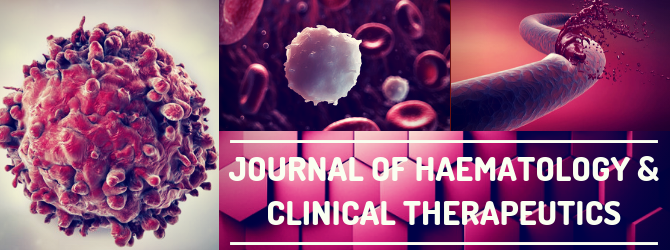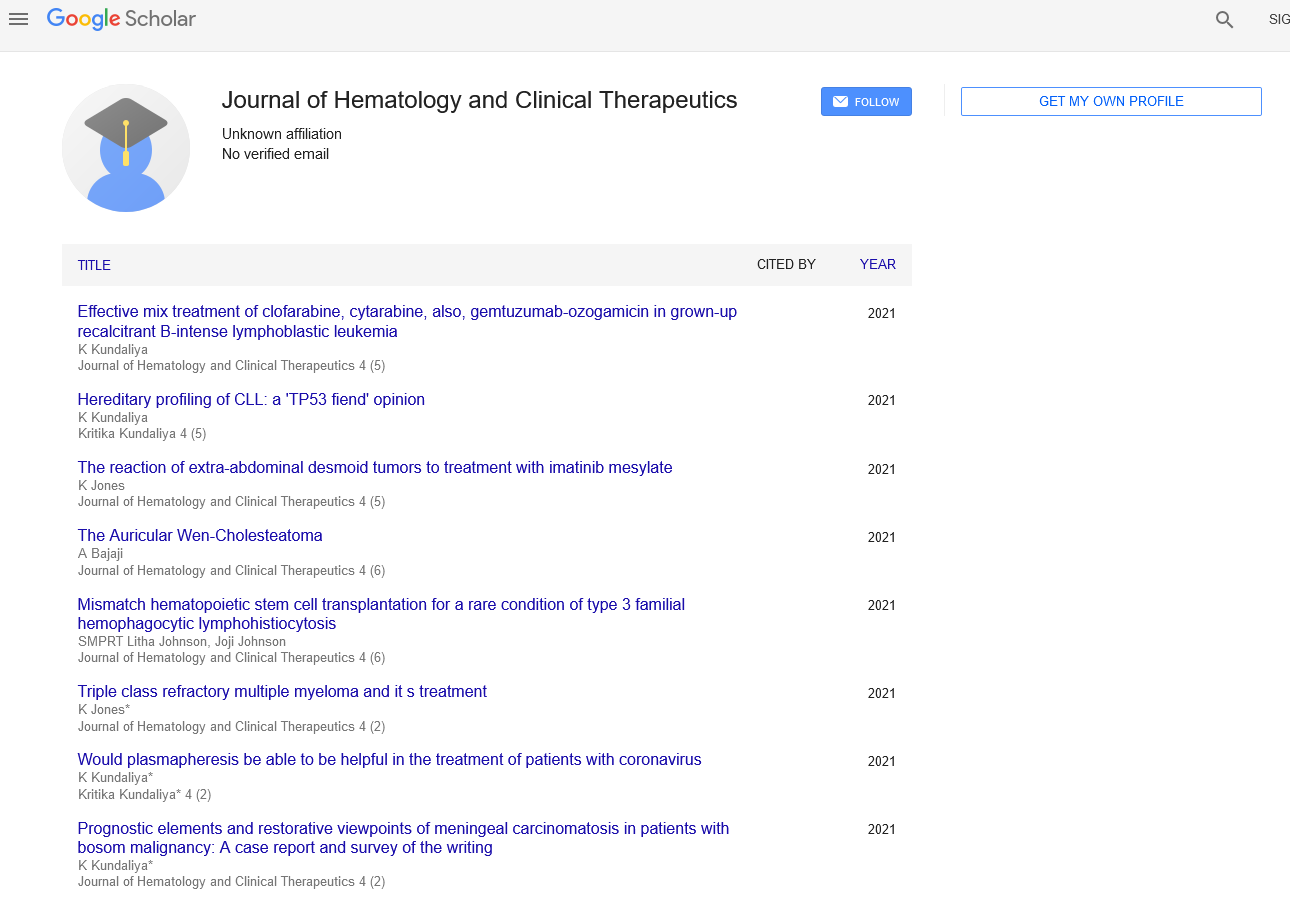
Sign up for email alert when new content gets added: Sign up
Instructions for Authors
Hematology and Clinical Therapeutics is a triannualy open access, peer-reviewed journal providing an international platform to publish eminent research work from all over the world by renowned research scholars, therefore aiding in enhancing the quality of the journal.The journal aims to commit to high standards by publishing quality work in the field of Haematology. The journal aims to publish original research articles, case-reports, review articles, commentaries, short-communication, letter-to-the-editor and various other types of articles on advanced and rare research work. Manuscripts on ethics and political issues affecting practice, as well as Letters to the Editor regarding articles published in previous issues of the Journal, are welcomed. Manuscripts are received with the understanding that they are submitted solely to Current Research: Integrative Medicine, and none of the material contained in the manuscript has been published previously or is under consideration for publication elsewhere, excluding abstracts. The Journal adheres to the Creative Commons Licence “Attribution − Non Commercial − CC BY-NC” for all OPEN ACCESS submissions. The publisher reserves commercial copyright on all published material, and permits individual copy reproduction and use in any medium provided the work is properly cited. For permission to reproduce and distribute multiple copies of the publication. Statements and opinions are the responsibility of the authors. Written approval by the local human institutional review committee must be stated in the manuscript.
Submit Manuscript at: publisher@pulsus.com or www.pulsus.com/submissions/haematology-clinical-therapeutics.html
Article Processing Charges (APC):
Average Article processing time (APT) is 45 days
TEXT Text files must be saved as .doc files.
Fast Editorial Execution and Review Process (FEE-Review Process):
Journal of Hematology and Clinical Therapeutics is participating in the Fast Editorial Execution and Review Process (FEE-Review Process) with an additional prepayment of $99 apart from the regular article processing fee. Fast Editorial Execution and Review Process is a special service for the article that enables it to get a faster response in the pre-review stage from the handling editor as well as a review from the reviewer. An author can get a faster response of pre-review maximum in 3 days since submission, and a review process by the reviewer maximum in 5 days, followed by revision/publication in 2 days. If the article gets notified for revision by the handling editor, then it will take another 5 days for external review by the previous reviewer or alternative reviewer.
Acceptance of manuscripts is driven entirely by handling editorial team considerations and independent peer-review, ensuring the highest standards are maintained no matter the route to regular peer-reviewed publication or a fast editorial review process. The handling editor and the article contributor are responsible for adhering to scientific standards. The article FEE-Review process of $99 will not be refunded even if the article is rejected or withdrawn for publication.
The corresponding author or institution/organization is responsible for making the manuscript FEE-Review Process payment. The additional FEE-Review Process payment covers the fast review processing and quick editorial decisions, and regular article publication covers the preparation in various formats for online publication, securing full-text inclusion in a number of permanent archives like HTML, XML, and PDF, and feeding to different indexing agencies.
Publishing Standards and Collaboration Policy
The journal actively collaborates and partners with reputed third-party journals and publishers to facilitate DOI assignment, content linking, and indexing across diverse platforms. This ensure maximum visibility and discoverability of your work. However, in alignment with international standards for science, technology, medicine and business publishing, the original copyright exclusively resides with our journal and its contributors. We are dedicated to protecting your authorship rights while enhancing the global impact and reach of your research.
TABLES:Type double-spaced, on a separate page from the rest of the text with the table number above the table and explanatory notes below. Table numbers should appear in Arabic numerals and should correspond to the order of the tables in the text. If abbreviations are used, an alphabetical listing must be included in the footnote. Written permission from the publisher to reproduce any previously published tables must be included.
FIGURE LEGENDS: Type double-spaced, separate from the rest of the text, with figure numbers corresponding to the order in which figures are presented in the text. Identify all abbreviations appearing on figures in alphabetical order at the end of each legend. Enough information should be given to allow interpretation of the figure without reference to the text. Written permission must be obtained from the publisher to reproduce any previously published figures. FIGURES 1) All figures have to be submitted in their original formats. The lettering, decimals, lines and other details on the figures should be sufficiently large to withstand reduction and reproduction. 2) Graphs must be created using Microsoft Word (.doc, .docx), Microsoft Power Point (.ppt, .pptx), Microsoft Excel (.xls, .xlsx), Corel Draw (.cdr) or Adobe Illustrator (.ai or .eps). 3) Photographs and graphics may be scanned at a resolution of no less than 300 dpi and saved as a .tif file. Place crop marks on photomicrographs to show the essential field and designate special features with arrows (which must contrast with the background). If necessary, the publisher will contact the author for original photographs or graphics, to ensure optimum quality. The first author’s last name, the figure number and the location of the ‘top’ must be indicated on the back of each proof. 4) Photographs and graphics will not be returned.
MANUSCRIPTS: All manuscripts must be accompanied by a covering letter detailing what is being submitted and indicating the author to whom correspondence and page proofs should be addressed; in the case of multiple authors (please include a contact address, telephone/fax numbers and e-mail address). Abbreviations and acronyms must be defined at first mention in the text. All measurements should be in SI units. Appropriate headings and subheadings should be provided in the Methods, Results and Discussion sections. References, figures and tables should be cited in the text with numbers assigned according to the order of mention in the text. Arrange the manuscript as follows: title page, summary, structured abstract and key words, introduction, methods, results, discussion, acknowledgements, references, figure legends, tables and figures. Do not import figures into the text file. Number the pages consecutively, beginning with the title page as 1. The last name of the first author should be typed at the top of each page
TITLE PAGE: In addition to the main title, a short running title of 45 characters or less and the authors’ names (including full, first or middle names) along with their qualifications and affiliations, should appear on the title page. Include the name of the institution from which the work originated
ABSTRACT: On a separate page, provide a structured abstract of no more than 250 words for major articles (including review articles). Abstracts for case reports need not be structured, but are limited to 150 words. The abstract should be substantive rather than purely descriptive. Abbreviate only standard units of measurement
KEY WORDS: At the end of the abstract, include a list of 3 to 6 key words or phrases for indexing purposes.
ACKNOWLEDGEMENTS: Brief acknowledgements may appear at the end of the text, before the references.
REFERENCES: Identify references in the text by Arabic numerals in parentheses on the line. Type the reference list double-spaced, separate from the text, with each reference numbered consecutively in the order mentioned in the text. References cited in figures and tables, but not in the text, should also be numbered following the text references. Personal communications, manuscripts in preparation and other unpublished data should not be cited in the reference list but may be mentioned in the text in parentheses. Identify abstracts with the abbreviation ‘Abst’ and letters to the editor by ‘Lett’ in parentheses; abstracts should not be cited if they are more than two years old. The style of references is that of Index Medicus. Journal references should contain inclusive page numbers; book references, specific page numbers; and Web site references, the date of last update, if available, and date of access (references to other types of electronic documents should include the format of the document). Abbreviations of journals should conform to those used in Index Medicus, National Library of Medicine. URLs should be included for all references publicly accessible via the Internet.
The style and punctuation of references are as follows:
Periodicals:
List all authors if 6 or fewer; otherwise, list first 3 and add ‘et al’. Do not use periods after authors’ initials. 1. Kohl P, Day K, Noble D, et al. Cellular mechanisms of cardiac mechano-electric feedback in a mathematical model. Can J Cardiol 1998;14:111-9.
Books:
2. Svensson LG, Crawford ES. Cardiovascular and Vascular Disease of the Aorta. Toronto: WB Saunders Company, 1997:184-5.
Chapter in book:
3. Trehan S, Anderson JL. Thrombolytic therapy. In: Yusuf S, Cairns JA, eds. Evidence Based Cardiology. London: BMJ Books, 1998:419-44.
Web sites:
4. National Library of Medicine. Images from the History of Medicine. (Accessed January 5, 1999).
POLICY ISSUES: All statements and opinions are the responsibility of the authors. With submission of the manuscript, a letter of transmittal must indicate that all authors have participated in the research, and have reviewed and agree with the content of the article. The publisher reserves commercial copyright on all published material, which may then not be reproduced without the written permission of the publisher.
CONFLICT OF INTEREST: All authors must disclose any commercial associations or other arrangements (eg, financial compensation received, patient-licensing arrangements, potential to profit, consultancy, stock ownership, etc.) that may pose a conflict of interest in connection with the article. This information will be made available to the editor and reviewers, and may be included as a footnote at the editor’s discretion.
ETHICS OF HUMAN AND ANIMAL EXPERIMENTS: If human subjects are involved, the text must indicate that all gave informed consent and that the protocol was approved by the institutional review committee. If experimental animals are used, provide a statement in the text to indicate that all procedures followed were in accordance with institutional policies.
PROOFS: Authors should keep a copy of their original manuscripts as page proofs will be sent to them without the manuscript. To avoid delays in publication, authors are required to return proofs within 48 hours by fax or e-mail. REPRINTS: Single reprints may be obtained from the author.
Reprints: in quantity must be purchased from Pulsus Group Inc. Reprints may not be purchased without the author’s permission.




